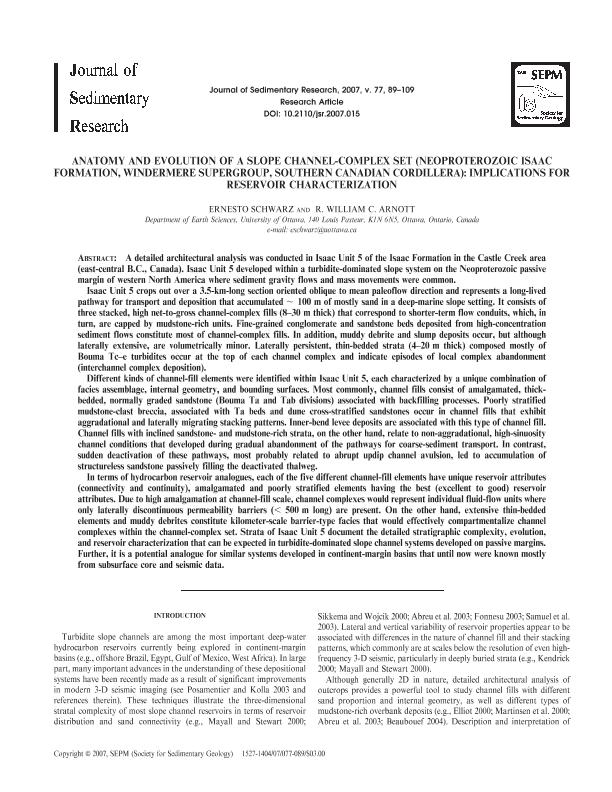Artículo
Anatomy and evolution of a slope channel-complex set (Neoproterozoic Isaac Formation, Windermere Supergroup, southern Canadian cordillera): Implications for reservoir characterization
Fecha de publicación:
01/2007
Editorial:
Society for Sedimentary Geology
Revista:
Journal of Sedimentary Research - (Print)
ISSN:
1527-1404
Idioma:
Inglés
Tipo de recurso:
Artículo publicado
Clasificación temática:
Resumen
A detailed architectural analysis was conducted in Isaac Unit 5 of the Isaac Formation in the Castle Creek area (east-central B. C., Canada). Isaac Unit 5 developed within a turbidite-dominated slope system on the Neoproterozoic passive margin of western North America where sediment gravity flows and mass movements were common. Isaac Unit 5 crops out over a 3.5-km-long section oriented oblique to mean paleoflow direction and represents a long-lived pathway for transport and deposition that accumulated ∼ 100 in of mostly sand in a deep-marine slope setting. It consists of three stacked, high net-to-gross channel-complex fills (8-30 in thick) that correspond to shorter-term flow conduits, which, in turn, are capped by mudstone-rich units. Fine-grained conglomerate and sandstone beds deposited from high-concentration sediment flows constitute most of channel-complex fills. In addition, muddy debrite and slump deposits occur, but although laterally extensive, are volumetrically minor. Laterally persistent, thin-bedded strata (4-20 m thick) composed mostly of Bouma Tc-e turbidites occur at the top of each channel complex and indicate episodes of local complex abandonment (interchannel complex deposition). Different kinds of channel-fill elements were identified within Isaac Unit 5, each characterized by a unique combination of facies assemblage, internal geometry, and bounding surfaces. Most commonly, channel fills consist of amalgamated, thick-bedded, normally graded sandstone (Bouma Ta and Tab divisions) associated with backfilling processes. Poorly stratified mudstone-clast breccia, associated with Ta beds and dune cross-stratified sandstones occur in channel fills that exhibit aggradational and laterally migrating stacking patterns. Inner-bend levee deposits are associated with this type of channel fill. Channel fills with inclined sandstone- and mudstone-rich strata, on the other hand, relate to non-aggradational, high-sinuosity channel conditions that developed during gradual abandonment of the pathways for coarse-sediment transport. In contrast, sudden deactivation of these pathways, most probably related to abrupt ubrupt channel avulsion, led to accumulation of structureless sandstone passively filling the deactivated thalweg. In terms of hydrocarbon reservoir analogues, each of the five different channel-fill elements have unique reservoir attributes (connectivity and continuity), amalgamated and poorly stratified elements having the best (excellent to good) reservoir attributes. Due to high amalgamation at channel-fill scale, channel complexes would represent individual fluid-flow units where only laterally discontinuous permeability barriers ( < 500 m long) are present. On the other hand, extensive thin-bedded elements and muddy debrites constitute kilometer-scale barrier-type facies that would effectively compartmentalize channel complexes within the channel-complex set. Strata of Isaac Unit 5 document the detailed stratigraphic complexity, evolution, and reservoir characterization that can be expected in turbidite-dominated slope channel systems developed on passive margins. Further, it is a potential analogue for similar systems developed in continent-margin basins that until now were known mostly from subsurface core and seismic data. Copyright © 2007, SEPM (Society for Sedimentary Geology).
Archivos asociados
Licencia
Identificadores
Colecciones
Articulos(CIG)
Articulos de CENTRO DE INVEST.GEOLOGICAS (I)
Articulos de CENTRO DE INVEST.GEOLOGICAS (I)
Citación
Schwarz, Ernesto; Arnott, R. William C.; Anatomy and evolution of a slope channel-complex set (Neoproterozoic Isaac Formation, Windermere Supergroup, southern Canadian cordillera): Implications for reservoir characterization; Society for Sedimentary Geology; Journal of Sedimentary Research - (Print); 77; 2; 1-2007; 89-109
Compartir
Altmétricas




